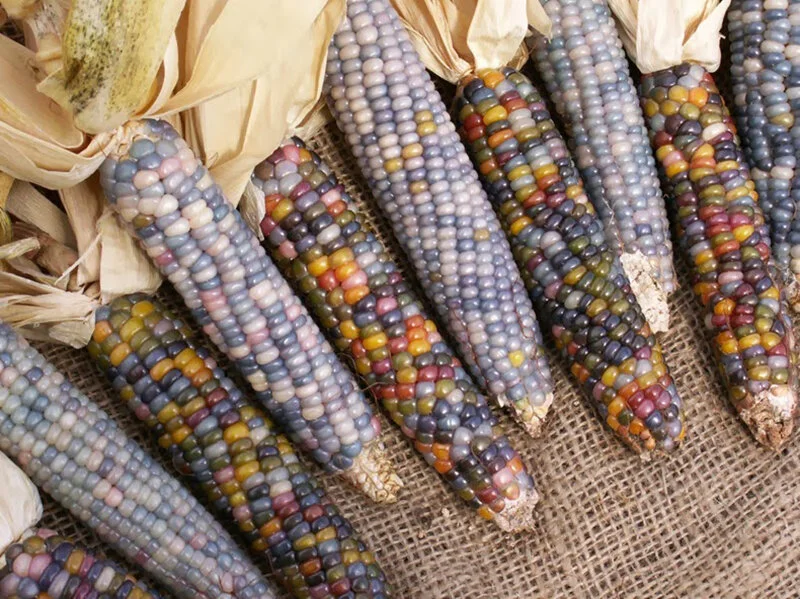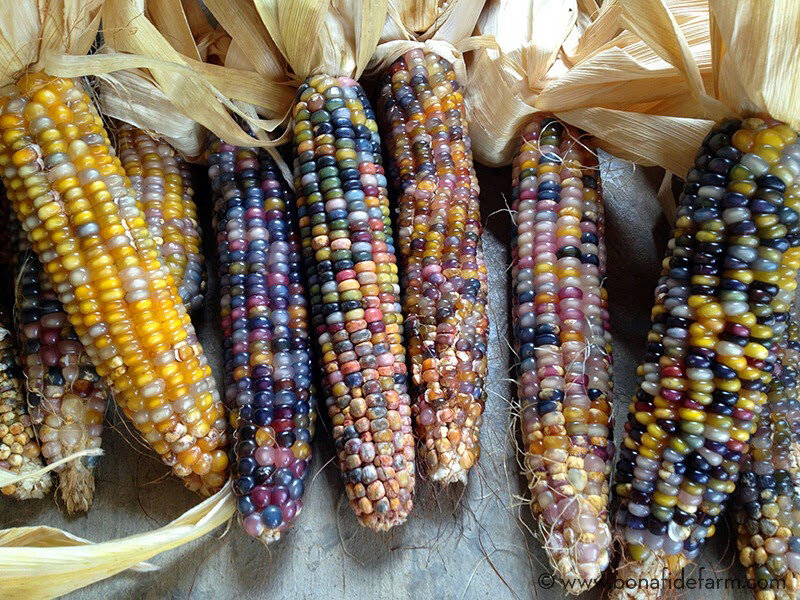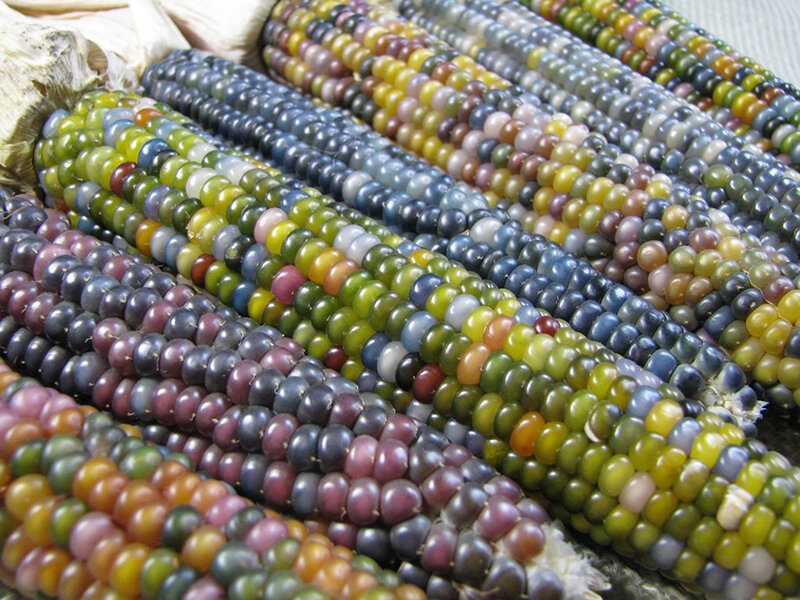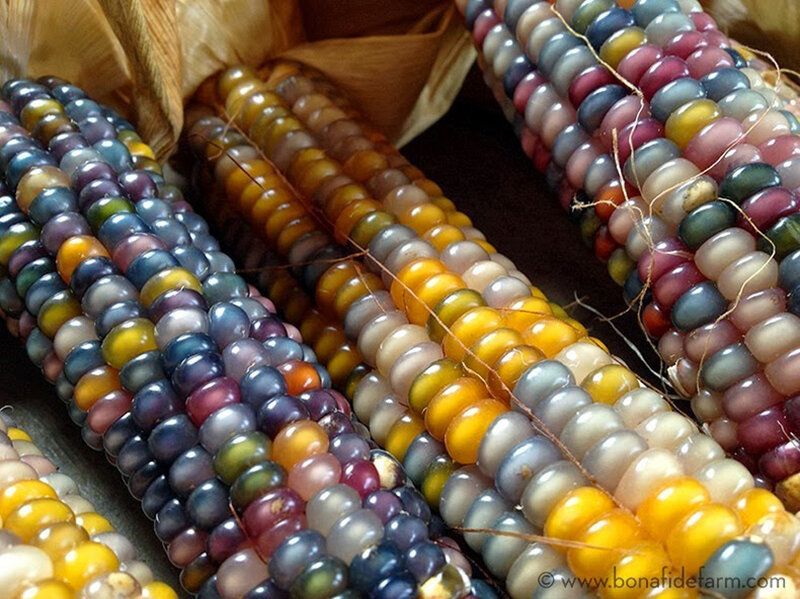The Story of Glass Gem Corn
Written by Stephen Thomas ~ Photos by Bonafide Farm
Like many heirloom treasures, Glass Gem corn has a name, a place, and a story. Its origin traces back to Carl Barnes, a part-Cherokee farmer living in Oklahoma. Barnes had an uncanny knack for corn breeding. More specifically, he excelled at selecting and saving seed from those cobs that exhibited vivid, translucent colors. Exactly how long Barnes worked on Glass Gem — how many successive seasons he carefully chose, saved, and replanted these special seeds — is unknown. But after many years, his efforts created a wondrous corn cultivar that has captivated thousands of people around the world.
Approaching old age, Barnes bestowed his precious seed collection to Greg Schoen, his corn-breeding protégé. The weighty responsibility of protecting these seeds was not lost on Schoen. While in the process of moving in 2010, he sought out a place to store a sampling of the collection to ensure its safekeeping. Schoen passed on several unique corn varieties to fellow seedsman Bill McDorman, who is a former Executive Director of Native Seeds/SEARCH. Curious about the oddly named Glass Gems, he planted a handful of seeds in his garden. The spectacular plants that emerged took him by surprise. “I was blown away,” McDorman recalls. “No one had ever seen corn like this before.”
The story of Barnes, Schoen, and their remarkable corn is not unusual. For millennia, people have elegantly interacted with the plants that sustain them through careful selection and seed saving. This process, repeated year after year, changes and adapts the plants to take on any number of desirable characteristics, from enhanced color and flavor to disease resistance and hardiness.
The bounty of genetic diversity our ancestral farmers and gardeners created in this way was shared and handed down across generations. But under today’s industrial agricultural paradigm of monocropping, GMOs, and hybrid seeds, this incredible diversity has been narrowed to a shred of its former abundance. A 1983 study compared the seed varieties found in the USDA seed bank at the time with those available in commercial seed catalogs in 1903. The results were striking. Of the 408 different tomato varieties on the market at the turn of the century, less than 80 were present in the USDA collection. Similarly, lettuces that once flourished with 497 heirloom varieties were only represented by 36 varieties. The same held true for most other veggies including sweet corn, of which only a dozen cultivars were preserved out of 307 unique varieties once available in the catalogs. Though this data leaves some questions around actual diversity decline, the trend toward dwindling crop diversity is alarming. In just a few generations, both the time-honored knowledge of seed saving and many irreplaceable seeds are in danger of disappearing.
Though much of this diversity may be gone, all hope is not lost. The emergence of a breathtaking heirloom variety like Glass Gem reveals that the art and magic of seed saving lives on. It reminds us that we can return to this age-old practice and restore beauty, wonder, and abundance to our world. Indeed, this renaissance is already underway. The rising seed library movement is encouraging local gardeners to become crop breeders and empowering communities to reclaim sovereignty over their food. Our pioneering Seed School program is training people from all walks of life in building sustainable local seed systems rooted in ancient traditions. And as eye-popping images of Glass Gem continue to spread around the world, Carl Barnes’ kaleidoscopic corn has become a beacon — and perhaps an inspiring symbol — for the global seed-saving revival.
To Purchase Glass Gem Seed:
Many people have contacted us looking to obtain Glass Gem seed. Demand has been very high for this rare variety. As such, our supplies are limited and vary according to the season. Check the Glass Gem listing on our website for current availability. For those that have asked about its edibility, Glass Gem is a flint corn used for making flour or as a popping corn. Unlike sweet corn, it is not typically eaten right off the cob. However, it was likely bred as an ornamental variety — for obvious reasons. Many of these exquisite ears are simply too beautiful to eat.
We encourage everyone who grows Glass Gem corn to rejoin the ritual of seed saving by setting aside your favorite selections for replanting the following year. Share seed with your friends and neighbors, organize a seed swap, or start a seed library in your community. Support Native Seeds/SEARCH in our work to conserve and protect Glass Gem corn along with the nearly 2,000 rare, aridlands-adapted crop varieties we steward in our seed bank. Your efforts and energy make a difference. As Carl Barnes has taught us, all it takes is one person to create a more colorful, diverse and abundant world — one seed at a time.
http://www.nativeseeds.org/
Our non-profit educational blog is dedicated to the “People Who Inspire Us” with the amazing work they are doing around the world. We love sharing stories, projects, and essays from the ecology experts, environmental activists, indigenous elders, cultural leaders, educators, filmmakers, artists and musicians that we admire most. All copyrights belong to their respective owners. For more information, check out our Site Terms.





